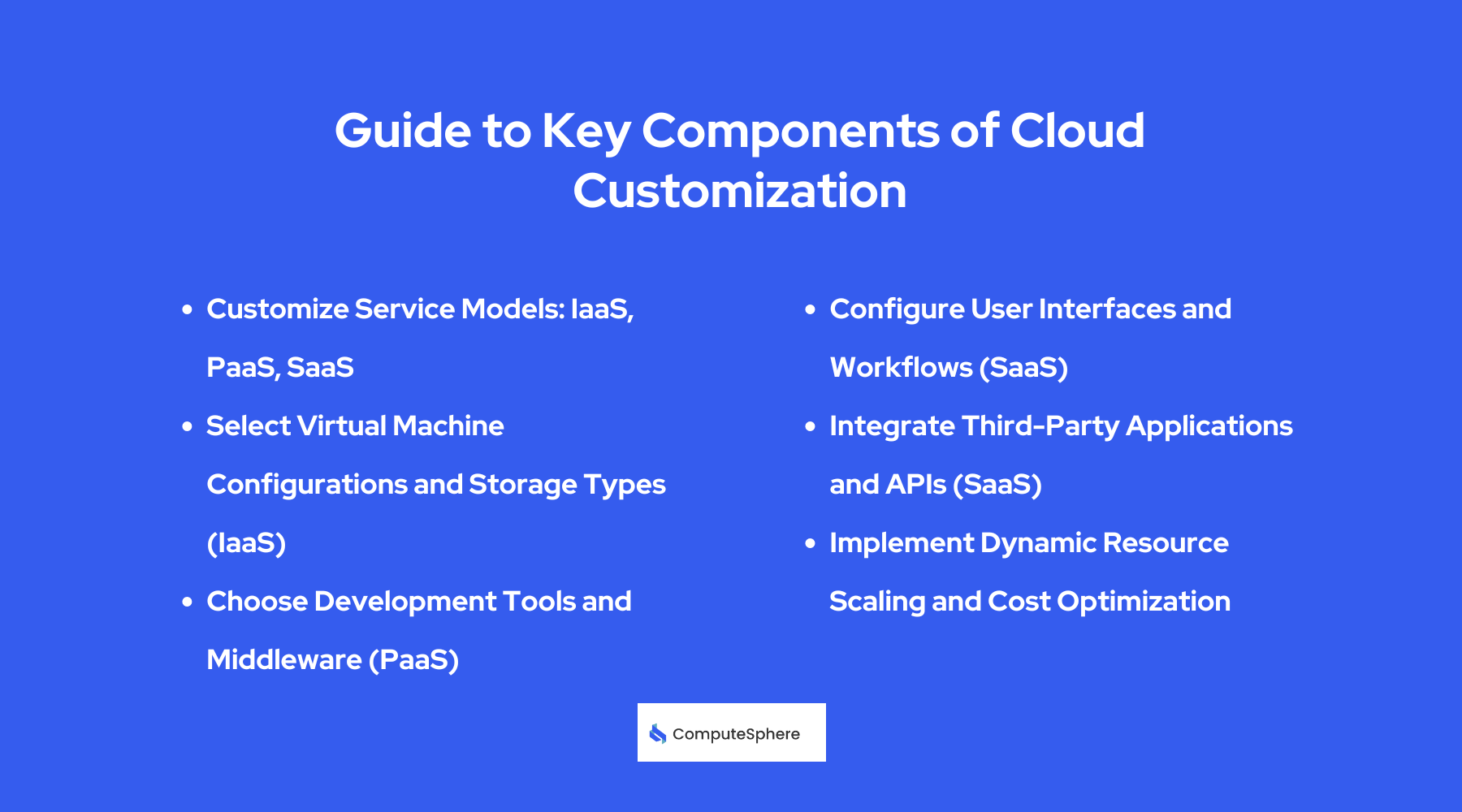Customizing Cloud Computing Services for Unique Business Requirements

Businesses always look for new ways to innovate, be more agile, and save costs. Cloud computing has become a major player in helping them achieve these goals. Because every business is different, a one-size-fits-all approach doesn't really work. To get the best results and meet unique goals, companies need to customize their cloud services. By doing this, they make the most out of what the cloud offers.
In this article, we’ll explore the best cloud solutions for your specific business needs, helping you stay ahead of the competition.
Cloud Computing Customization
Cloud computing customization refers to the process of modifying and configuring cloud services to meet the specific needs of an organization. Unlike standard cloud offerings, customized solutions allow businesses to use the full potential of the cloud by designing resources, applications, and services to their unique requirements.
Customizing cloud computing services brings several benefits. It ensures that businesses only pay for what they use, improving cost efficiency. It also improves flexibility, enabling organizations to scale resources up or down based on demand. For instance, a retail company might need additional computing power during the holiday season, while a startup may require scalable storage solutions as it grows.
Assessing Unique Business Requirements
Before stepping into cloud customization, it is essential to assess the unique requirements of your business. Start by identifying specific business needs and goals. This could involve improving data security, improving application performance, or enabling faster time-to-market for new products.
Next, access your current IT infrastructure. Understanding the existing setup helps in determining how cloud services can be integrated and customized. For example, if your business relies heavily on legacy systems, you might need a hybrid cloud solution that seamlessly integrates with on-premises infrastructure.
Aligning cloud solutions with business goals is also equally important. If your objective is to expand globally, choosing a cloud provider with a powerful global network is necessary. Conversely, if compliance with local regulations is a priority, a provider with strong compliance abilities should be considered.
Key Components of Cloud Customization

Cloud computing presents various service models that can be customized to suit different business needs. These include Infrastructure as a Service (IaaS), Platform as a Service (PaaS), and Software as a Service (SaaS).
IaaS provides virtualized computing resources over the internet. Customization options in IaaS include selecting specific virtual machine configurations, storage types, and network setups. Businesses can also deploy custom security measures and integrate their existing IT systems.
PaaS offers a platform allowing businesses to develop, run, and manage applications without dealing with the underlying infrastructure. Customizing PaaS involves choosing development tools, programming languages, and middleware that align with your development processes.
SaaS delivers software applications over the internet on a subscription basis. Customization in SaaS can range from configuring user interfaces and workflows to integrating third-party applications and APIs.
Scalability and flexibility are important aspects of cloud customization. Businesses need the ability to scale resources based on demand without incurring unnecessary costs. For instance, an e-commerce platform experiencing fluctuating traffic volumes should be able to scale its infrastructure dynamically.
Choosing the Right Cloud Provider
Selecting the right cloud provider is a vital step in customizing cloud services. Factors to consider include the provider's range of services, pricing models, security features, and support options. Conducting a thorough comparison of major cloud providers such as Amazon Web Services (AWS), Microsoft Azure, and Google Cloud can help in making your way.
AWS offers many services and customization options, making it suitable for businesses with distinct needs. Azure is known for its strong integration with Microsoft products, making it a preferred choice for enterprises using Windows-based systems. Google Cloud is best in data analytics and machine learning capabilities, ideal for businesses focusing on data-driven values.
Cloud computing companies often provide extensive customization options. These include configuring virtual machines, storage solutions, networking components, and application services to fit specific requirements.
Implementing Custom Cloud Solutions
Implementing custom cloud solutions requires a key approach. Begin with a well-planned migration strategy that outlines the steps for moving existing applications and data to the cloud. This plan should include timelines, resource allocations, and risk mitigation measures.
Ensure minimal disruption to business operations during migration. Use phased migration techniques, where workloads are moved in stages, allowing for testing and adjustments. This approach helps in identifying and resolving issues before they impact critical business functions.
Custom cloud solutions should be designed to integrate seamlessly with existing systems. This might involve using APIs, middleware, or other integration tools to ensure smooth communication between cloud and on-premises applications.
Security and Compliance Considerations
Security is a very important concern when customizing cloud solutions. Implement powerful security measures such as encryption, multi-factor authentication, and regular security audits. These measures protect sensitive data and ensure compliance with industry regulations.
Addressing compliance requirements involves understanding the regulations of your industry. Cloud providers often offer compliance certifications and tools to help businesses meet these standards. For example, healthcare organizations must comply with HIPAA regulations, while financial institutions need to adhere to PCI DSS standards.
Best practices for securing cloud computing environments include conducting regular vulnerability assessments, implementing access controls, and maintaining an incident response plan.
Optimizing Performance and Costs
Optimizing the performance of custom cloud solutions involves monitoring resource usage and adjusting configurations as needed. Cloud monitoring and performance analysis tools can provide insights into resource utilization and identify areas for improvement.
Cost optimization is another important aspect. Implement strategies such as resizing resources, using cost-effective storage solutions, and using reserved instances to reduce expenses. Many cloud providers offer cost management tools to help businesses track and control their spending.
Cloud computing roles, such as cloud architects, engineers, and administrators, play a vital role in managing and optimizing custom cloud solutions. These professionals ensure that the cloud infrastructure is running efficiently and effectively business operations.
Future Trends in Cloud Customization
The future of cloud customization is largely influenced by emerging technologies and new business needs. Artificial intelligence (AI) and machine learning (ML) are increasingly being integrated into cloud services with advanced analytics, automation, and predictive capabilities. These technologies enable businesses to gain deeper insights and make data-based decisions.
Another trend is the rise of multi-cloud and hybrid-cloud environments. Businesses are adopting multiple cloud providers to avoid vendor lock-in and improve resilience. Hybrid cloud solutions, which combine public and private clouds, provide the flexibility to run workloads in the most suitable environment.
Serverless computing is also gaining its place. This model allows businesses to run applications without managing the underlying infrastructure, leading to cost savings and faster deployment times.
Conclusion
Customizing cloud computing services is essential for businesses seeking to use the full potential of the cloud. By designing cloud solutions to unique business requirements, organizations can achieve greater flexibility, scalability, and cost-efficiency. As the cloud domain continues to emerge, staying informed about emerging shifts and best practices will be crucial for maintaining a competitive edge. Businesses are encouraged to explore customized cloud solutions and take advantage of the numerous benefits they offer.
Contents
Built for Builders. Priced for Startups.
Tired of unpredictable cloud bills? ComputeSphere offers modular, fixed-cost cloud hosting that grows with your startup—no DevOps headaches, no surprises.
Get StartedShare this article
Browse Some Related Blogs
Relevant and related contents you can read









